How to grow fruit trees

Grow your own delicious tree fruits
Image: Nectarine 'Madame Blanchette' from T&M
Growing fruit trees is fun and rewarding. And there’s a huge selection from which to choose, including hybrid dwarf fruit trees which thrive in containers, through to full size heritage fruit trees which will feed the whole family for many years to come. Here are our tips to help you choose the right tree for your space, including how and when to plant it.
How to choose the right fruit tree

Make your fruit tree work for you
Image: Fig 'Little Miss Figgy' from Thompson & Morgan
Start by thinking of your favourite fruit - cherries, apples, pears and medlars are a tiny proportion of the fruit trees that can be grown outdoors in the UK. It sounds obvious, but plant a variety you love, because you’ll be harvesting the fruit for many years to come. And you don’t need to stick to traditional British favourites. Take a look at our ‘eight exotic fruits to grow in the UK’ article if you dream of harvesting your own pomegranates and sharon fruit!
One of the most important things to consider when buying a fruit tree is the size it will reach at maturity. Read up on fruit rootstock, because most fruit trees are grafted onto a different root system that controls the final size. Choosing the right rootstock is almost as important as getting the right variety. The rootstock also contributes to improved vigour and disease resistance too, so it's well worth choosing a grafted tree over a non-grafted tree.
If you have limited space but want a selection of fruit, you could try an apple and pear tree family collection. You’ll receive two fruit trees, one apple and one pear, but each tree will provide you with three different types of fruit. Not only are these multi-grafted fruit trees self-pollinating and versatile, they’re a great way to enjoy three types of apple and three types of pear without having to plant six trees!
And if you have a very small garden or even just a balcony, dwarf fruit trees are ideal for growing in containers. These trees are bred to stay compact, reaching about one metre in height, and will produce plenty of fruit as long as you position them in a sunny spot.
How to plant fruit trees

Plant a tasty mixture of cooking and eating apples
Image: Apple 'Bramley's Seedling' from Thompson & Morgan
Once you’ve chosen your fruit tree, you’ll need to find a good spot for it to grow - a sunny and sheltered position with good quality and well-drained soil is ideal. Avoid the bottoms of valleys or other low areas, as these can turn to frost pockets in the winter causing blossom drop and poor harvests. Remember to allow plenty of room around the planting site for your tree to grow to maturity in future years.
Here’s our step-by-step guide to planting your fruit tree in the ground:
- Prepare your chosen spot by digging plenty of well-rotted manure or compost into the soil.
- Make the planting hole wide enough to allow plenty of space for the root ball or bare roots to spread through freshly turned soil.
- Hammer a stake into the planting hole. Make sure it’s firmly planted and tall enough to support the tree properly.
- Place your tree into the planting hole, making sure the juncture between root and trunk is level with the soil surface.
- Backfill the planting hole and firm the soil above the roots with your boot.
- Water your newly planted fruit tree very well.
- Use a loose tie to secure the young tree to the stake. Old tights are good for this. Make sure there’s an inch or two leeway for the trunk to move.
- Mulch around the base of the planted tree, but keep the trunk free of material.
- Frequently water the soil around your young fruit tree, making sure that water penetrates the surface encouraging the tree to develop deeper roots.
If you’re planting on a larger scale, like an entire orchard, bareroot fruit trees may prove the most cost-effective solution. Bare root saplings are best planted between November and March, but for more information read our guide on growing bareroot trees.
Remember that your young fruit trees will take a few years to properly establish and start producing large crops. If you’re growing them on your patio, use a large container and a soil-based compost such as John Innes No. 3. Keep an eye on the moisture levels as they need more water than those grown in the ground.
How to care fruit trees
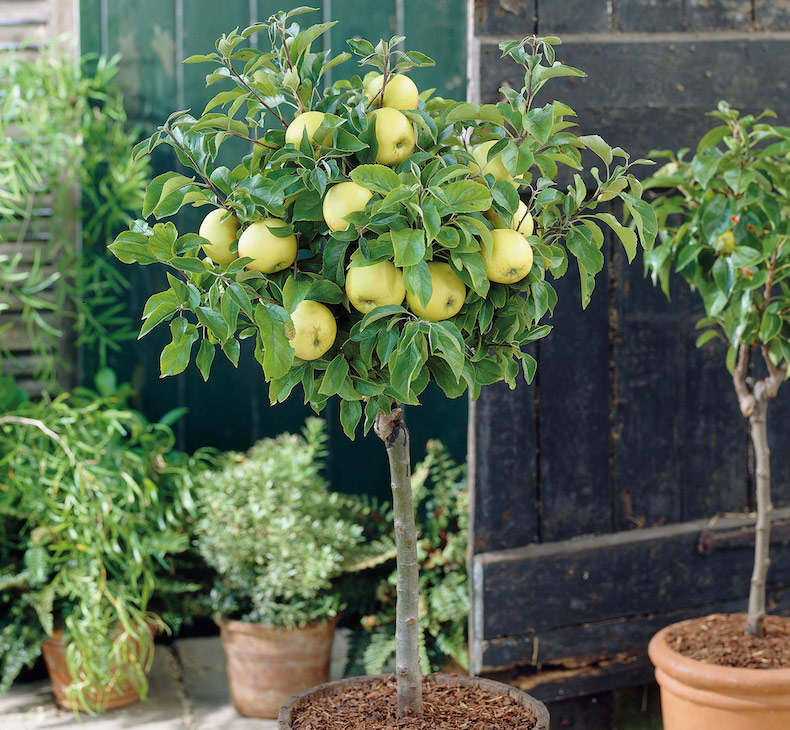
Watering fruit trees, like this 'Golden Delicious' variety, until they are properly established is very important
Copyright: Visions BV, Netherlands
Over the first two years, regularly water your trees to keep the soil around the roots moist. This is crucial during year one, when top leaf growth is faster than underground root development. The roots need extra water to be able to support this rapid growth.
Feeding your tree isn’t necessary, but will promote healthy above-ground growth. Use a balanced fertiliser during the growing season if you feel like your trees need it. You can also remove the support stake after two years - by this point the roots should be sufficiently developed to anchor the tree in windy conditions.
When and how should I prune my fruit trees?

Pruning keeps fruit trees tidy and healthy
Image: Fruiting Lemon Bush from Thompson & Morgan
Apple and pear trees are best pruned between November and February, when the tree is dormant and the lack of leaves makes it easier to see the overall shape. However you should wait until the summer to prune cherry trees, plums, apricots, and peaches. This greatly reduces their risk of contracting silver leaf disease.
The aim of pruning is to create a healthy tree with an open centre and no crossing branches. This open, ‘goblet’ shape allows plenty of light to reach and ripen the fruit, and encourages good air circulation which reduces the likelihood of disease. It’s important to get a good shape at the beginning, as it’s more difficult to solve mistakes when the tree is larger. To prune your fruit tree you should:
- Take out any dead or diseased growth.
- Remove any branches that cross or rub against each other.
- Aim for a goblet shape.
- Try to cut branches back to an outward facing bud, to encourage growth away from the centre of the tree.
- Always use clean and sharp equipment.
Some people like to make use of the vertical spaces against walls or fences to grow their fruit trees. Taking up far less room in the garden, these cleverly ‘trained’ trees require specialist pruning to maintain their unusual shapes. The three most common styles are cordon, espalier and fan-trained. Easier to achieve than you might imagine, here’s a quick summary of each:
1. What is a cordon fruit tree?
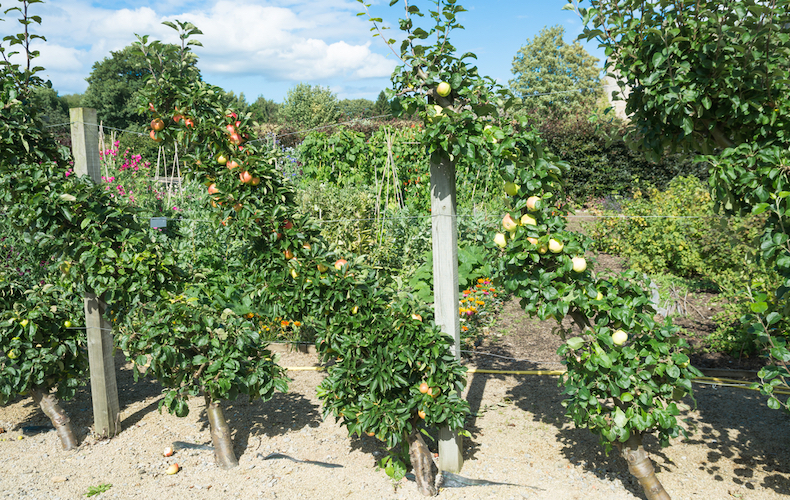
Cordon fruit trees are usually trained at a 45 degree angle
Image: high flyers/Shutterstock
A cordon fruit tree is trained as a single stem, with short horizontal side spurs bearing the fruit. It’s usually planted at a 45 degree angle to increase the fruit-bearing capacity. Cordon trees are trained from their first year, and are only productive using spur-bearing varieties.
2. What is an espalier fruit tree?
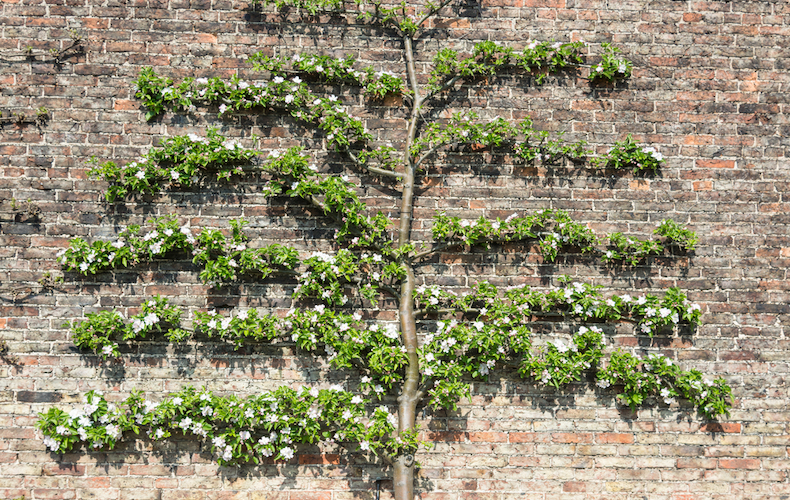
Espalier fruit trees require careful training
Image: Andrew Fletcher/Shutterstock
An espalier tree is trained to produce long horizontal side branches, usually against a supporting wall or along horizontal wires between posts. Espalier trees require specific rootstock and careful pruning from the first year of planting, but the attractive architectural finish is definitely worth the effort!
3. What is a fan-trained fruit tree?
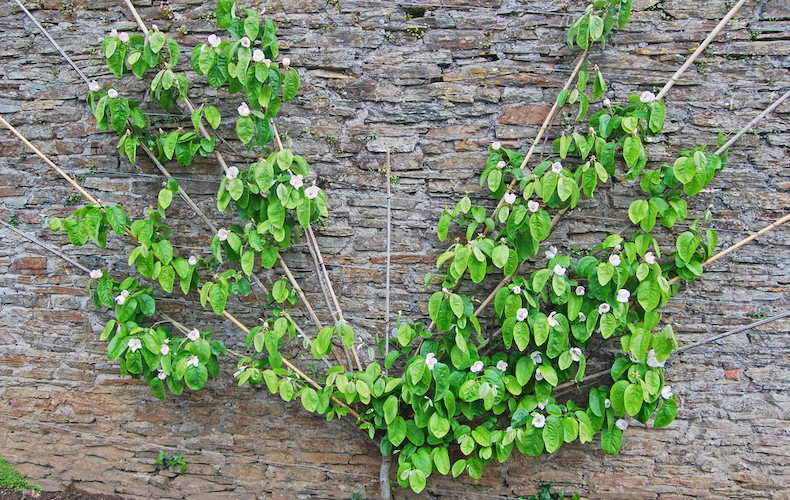
Fan trained fruit trees look fantastic as a feature on a south facing wall
Image: Deatonphotos/Shutterstock
A fan-trained fruit tree develops flat against a wall or fence with multiple stems erupting from one very short main stem. This space-saving shape can help fruit ripen, especially if a heat-retaining south-facing wall is used. It’s a fairly low-maintenance growth strategy once the fruit-bearing fanned stems are established.
Should I thin the fruit on my fruit trees?
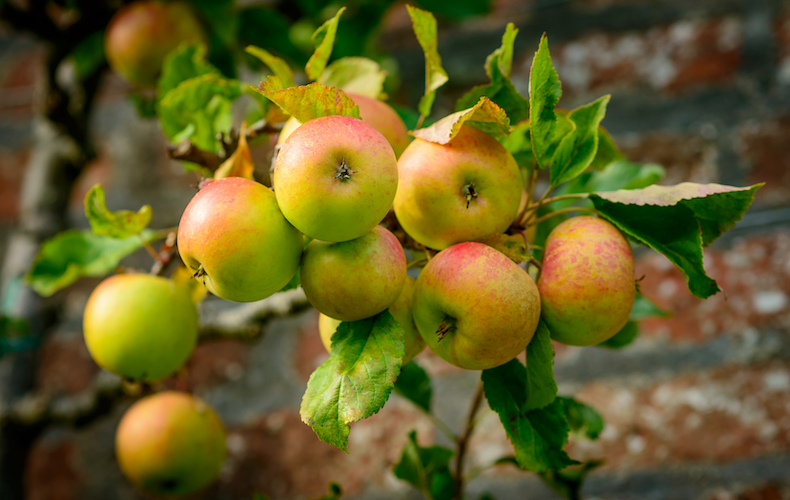
Branches can become very heavy under the weight of developing fruit
Image: Apple 'Blenheim Orange' from Thompson & Morgan
Thinning the number of fruitlets on your fruit tree will increase the size of individual fruits come harvest, but reduce the total amount of fruit. Fruit trees 'set' fruit around mid-June, and these fruit clusters are sometimes large, which is fine if you’re after a larger yield of smaller fruits. As well as increasing the fruit size, thinning is a chance to remove misshapen, scarred, or diseased fruitlets before they develop.
More importantly, thinning your fruit reduces the weight on each branch and prevents them from snapping or breaking. Broken branches mean you lose fruit, and they provide an easy place for diseases to enter. Trees sometimes naturally drop surplus fruit, called the ‘June’ drop, so it’s best to wait until after this time to thin your fruit trees.
We hope you find our guide to growing your own fruit trees helpful. For more information on fruit trees, head over to our hub page to find top tips on preventing disease, growing exotic fruit and much more. Share your images with us on Twitter or Instagram using the hashtag #YourTMGarden.
Sign Up For Exclusive Special Offers




© 2024 Thompson & Morgan. All rights reserved. A division of Branded Garden Products Limited.



